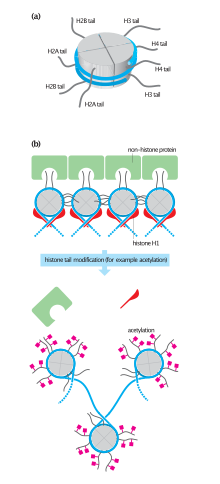Histone H2B
Histone H2B is one of the 5 main
Structure

Histone H2B is a lightweight structural protein made of 126 amino acids.[2] Many of these amino acids have a positive charge at cellular pH, which allows them to interact with the negatively charged phosphate groups in DNA.[3] Along with a central globular domain, histone H2B has two[verification needed] flexible histone tails that extend outwards – one at the N-terminal end and one at C-terminal end. These are highly involved in condensing chromatin from the beads-on-a-string conformation to a 30-nm fiber.[3] Similar to other histone proteins, histone H2B has a distinct histone fold that is optimized for histone-histone as well as histone-DNA interactions.[1]
Two copies of histone H2B come together with two copies each of histone H2A, histone H3, and histone H4 to form the octamer core of the nucleosome[2] to give structure to DNA.[3] To facilitate this formation, histone H2B first binds to histone H2A to form a heterodimer.[2] Two of these heterodimers then bind together with a heterotetramer made of histone H3 and histone H4, giving the nucleosome its characteristic disk shape.[3] DNA is then wrapped around the entire nucleosome in groups of approximately 160 base pairs of DNA.[1] The wrapping continues until all chromatin has been packaged with the nucleosomes.[4]
Function

Histone H2B is a structural
Acetylation and
While only a few
DNA damage response
Ubiquitination of histone H2B in response to DNA damage is important for timely initiation of DNA repair.[8] Ubiquitinase RNF20/RNF40 specifically modifies histone H2B at position K120 and this modification is need for recruitment to damaged DNA of the factors necessary for repair by the pathways of homologous recombination and non-homologous end joining.[8]
Isoforms
There are sixteen variants of histone H2B found in humans, thirteen of which are expressed in regular body cells and three of which are only expressed in the testes. These variants, also called isoforms, are proteins that are structurally very similar to the regular histone H2B but feature some specific variations in their amino acid sequence.[4] All variants of histone H2B contain the same number of amino acids, and the variations in sequence are few in number. Only two to five amino acids are changed, but even these small differences can alter the isoform’s, higher level structure.[4]
Histone H2B isoforms interact differently with other proteins, are found in specific regions of chromatin, have different types and numbers of post-translational modifications, and are more or less stable than regular histone H2B. All of these differences accumulate and cause the isoforms to have unique functions and even function differently in different tissues.[4]
Many histone H2B isoforms are expressed in a DNA replication independent manner. They are produced at the same level during all phases of the cell cycle. Regular histone H2B is only added to nucleosomes during the S-phase of the cell cycle when DNA is replicated; histone H2B isoforms can be added to nucleosomes at other times during the cell cycle.[4] Histone variants of H2B can be explored using "HistoneDB with Variants" database.
Post-Translational Modifications
Histone H2B is modified by a combination of several types of post-translational modifications.[1] These modifications affect the structural and functional organization of chromatin,[9] and the majority of them are found outside the globular domain of the nucleosome where amino acid residues are more accessible.[7] Possible modifications include acetylation, methylation, phosphorylation, ubiquitination, and sumoylation.[9] Acetylation, phosphorylation, and ubiquitination are the most common and most studied modifications of histone H2B.
Acetylation
Histone H2B proteins found both in the
O-GlcNAcylation
Modification of H2B S112 with O-GlcNAc is thought to facilitate monoubiquitination of K112, which in turn is associated with transcriptionally activated regions.[10]
Phosphorylation
In histone H2B, a phosphorylated
Ubiquitination
Ubiquitin residues are usually added to the
Genetics
Histone H2B’s
See also
- Histone code
- Nucleosome
- Chromatin
- Other histone proteins:
References
- ^ PMID 16472024.
- ^ PMID 26359231.
- ^ ISBN 978-1-4292-3413-9.
- ^ PMID 25922622.
- ^ PMID 26343795.
- ^ a b c "Histone H2B (53H3) Mouse mAb #2934". Cell Signaling Technology. Retrieved 24 November 2015.
- ^ PMID 16772277.
- ^ a b Uckelmann M, Sixma TK. Histone ubiquitination in the DNA damage response. DNA Repair (Amst). 2017 Aug;56:92-101. doi: 10.1016/j.dnarep.2017.06.011. Epub 2017 Jun 9. PMID: 28624371
- ^ S2CID 25071586.
- PMID 22121020.
- ^ Khare SP, Habib F, Sharma R, Gadewal N, Gupta S, Galande S. "Histone H2B". HIstome: A Relational Knowledgebase of Human Proteins and Histone Modifying Enzymes. Nucleic Acids Research. Archived from the original on 16 October 2016. Retrieved 24 November 2015.
